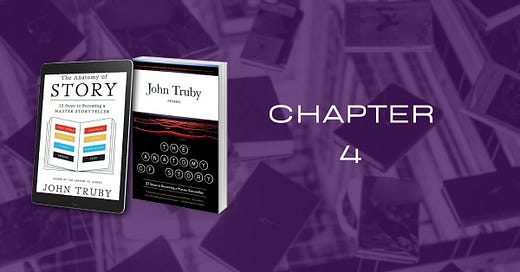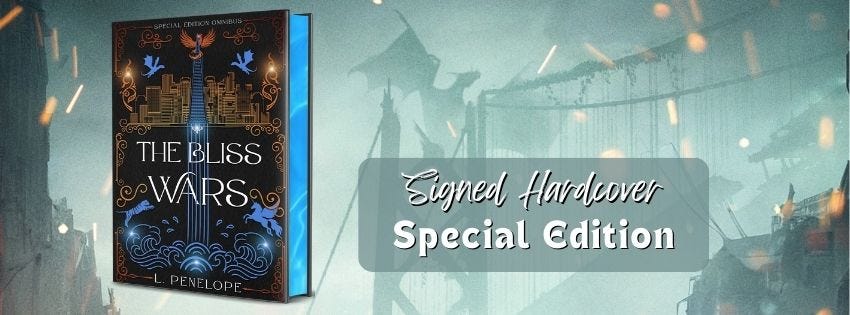Fascinating & Flawed: Building Characters
Chapter 4 of The Anatomy of Story by John Truby (continued)
Welcome back to the Marginalia Book Club! Yesterday we explored the web of character relationships, and today we're focusing on how to create characters based on Chapter 4 of The Anatomy of Story: 22 Steps to Becoming a Master Storyteller by John Truby (Bookshop | Barnes & Noble | Amazon).
Creating Your Hero
What makes a protagonist compelling? According to Truby, a great hero must be "constantly fascinating" and mysterious enough to keep readers turning pages. But beyond that initial intrigue, readers need to identify with the hero's desire and moral problem rather than with every aspect of their personality.
Truby makes an important distinction between empathy and sympathy. Our audience should empathize with our heroes — understand and care about them — rather than merely sympathize with them. The key to achieving this? Showing clear motivation.
This reminds me of one of the most powerful lessons from my early writing journey—that GMC (Goal, Motivation, and Conflict) is the foundation of story. If you haven't read Debra Dixon's excellent book on this concept, I highly recommend it.
Sidebar: I recently DNF'd a very well-regarded, NYT bestselling book because not only did I not care about the main character, I didn't like him, nor did I like or even respect his motivation. Despite the author's skill and the book's acclaim, I simply couldn't empathize with him—even when terrible and unfair things happened. The book became a torturous slog, which just goes to show how crucial character empathy is to reader engagement.
Character Change
Truby heads into a very philosophical discussion of what constitutes the "self" that changes during a character arc. He advises thinking of protagonists as "a range of change, a range of possibilities," which honestly strikes me as an odd way to view characters.
For me, characters are people with all their foibles, strengths, and weaknesses. It feels calculating to view them merely as "ranges." While I agree that significant character transformation creates compelling reading experiences, each character needs to evolve in their own authentic way.
“Your hero’s development depends on what beliefs he starts with, how he challenges them, and how they have changed by the end of the story.”
Truby outlines several types of character change including going from child to adult, adult to leader, leader to tyrant.
A helpful technique for creating change is to start at the end of the character arc and backtrack to its opposite at the beginning. I've found this technique incredibly useful when I'm stuck — working backward through cause and effect can unlock both plot and character development.
The Power of Desire
One of Truby's strongest points is that our protagonists should have only one primary desire line. Otherwise, the story splinters in multiple directions and loses narrative drive.
For me, this brought to mind the idea of a story question. Often when my friends are stuck with narrative issues, I'll ask them what the story question is. What is the question that after you’ve answered it, you know the story is done?
How do we know when Star Wars: A New Hope is done? When they've destroyed the Death Star. What about the movie, The Proposal? Since it’s a romance, the story question is answered when Ryan Reynolds and Sandra Bullock admit their love for each other and get engaged for real. In the external plot, since their faking an engagement because of Bullock’s green card issues, we know when the story is done when she’s either on her way to citizenship or deported.
The protagonist's desire line or goal is established early, and while there may be sub-goals along the way, there's only one overarching objective. A character's desire should be clearly defined so readers know whether they've won or lost.
Crafting the Opponent
A compelling opponent should be:
Necessary to the story
Human in their complexity
Holding values that oppose the protagonist's
Armed with a strong but flawed moral argument
Killmonger from Black Panther perfectly embodies these qualities. So does Remmick in Ryan Coogler's latest film, Sinners (which you should absolutely go see immediately if you haven't already).
Building Conflict
Truby also advocates a technique called "four-corner opposition" where the protagonist faces a main opponent and two lesser ones. Ideally, all opponents should attack the hero's weakness in different ways and also be in conflict with one another. To add depth both actions and values should clash among all parties. Also, everyone should be as different as possible so we can easily differentiate them. And conflict should operate on multiple levels. For example, interpersonal, societal, or institutional.
The book includes some charts and columns to illustrate examples of these relationships, but they don't render too well in the ebook and are best viewed in print.
Final Thoughts
Throughout these pages, Truby makes strong statements about what makes stories succeed or fail and elements that "almost always" sink narratives. Personally, I find these all or nothing type statements a bit difficult to digest.
We can all think of countless successful stories with cardboard villains who lack complexity or strong moral arguments. Marvel has made billions with them! This absolutist framing sometimes distracted me while reading.
It's important to remember we're reading one person's opinions, which shouldn't be taken as gospel. Take what resonates with you and leave the rest.
📢 What type of character change do you prefer writing or reading about?
📢 Do you agree that a hero should have only one desire line?
📢 What's your approach to creating opponents who feel human and complex?
Let's discuss in the comments!
Imaginary Best Friends, head here to download the bonus worksheet for this section!
I’m celebrating my 10 year publishing anniversary with a limited special hardcover edition of my enemies-to-lovers, portal fantasy romance series, The Bliss Wars.
If you love stories filled with warring shifter clans, forbidden love, and heart-pounding adventure, this series is a must-read. And this edition? It’s a true collector’s dream: a brand-new foiled cover (so pretty 😍), custom printed edges, beautiful chapter designs, interior character artwork, and even a bonus scene!
The preorder campaign is all-or-nothing (the books won’t get printed unless we meet the gaol) and we’re already more than halfway there! When you reserve your copy, you won’t be charged until the campaign is fully funded — and books will ship in early June.
✨ Don’t miss your chance to own this gorgeous special edition! ✨
More about the trilogy:
In a shattered world of rival shifter clans, ancient prophecies, and dangerous secrets, three forbidden love stories unfold.
Talia, a lost soul mistaken for royalty, must navigate lies and a deadly war to uncover her place in a city divided. Xipporah, a warrior consumed by vengeance, risks everything by marrying her enemy to save her people. And a princess fighting to become a queen discovers her greatest strength while trapped in an abandoned fortress—and in the arms of a terrifying beast.
As alliances crumble, enemies turn to lovers, and sacrifices mount, The Bliss Wars trilogy weaves a gripping tale of love, loyalty, and survival in a world on the brink of annihilation.





